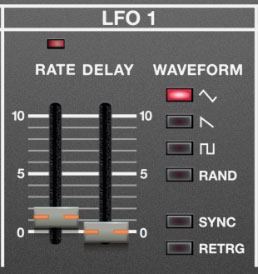
LFO 1 (low-frequency oscillator ) generates sub-audio range signals intended for modulation purposes.
Rate- The Rate slider sets the speed of the LFO, from 0.03 to 100 Hz (with Sync button off) or from 8 beats up to 1/64th note triplets (Sync button on). The LED above the Rate slider flashes at the current modulation rate.
Delay- Moving this slider up gradually delays the onset of LFO depth. The delay time can be set from 0 to 5 seconds. Keep in mind that like the original, there's only one LFO per layer. This means LFO Delay is monophonic; that means LFO onset delay occurs when you play one or more notes, and the LFO amount for additional notes played will not be delayed if other notes are currently held. LFO delay resets when all notes are released.
We should also mention that the onset curve is a little funky, that is, it's not really linear. At higher Delay time settings, you won't hear any LFO mod for a while, then it fades in pretty quick. This is exactly how the original JP-6 worked, and if you think about it, it's probably musically useful.
Waveform- Selects the repeating pattern of the LFO. Available waveforms are triangle, sawtooth, square, and random (aka, sample & hold). Only one waveform can be selected at any time.
Sync- When the Sync button is enabled, LFO speed will lock to host tempo when using Mercury-6 within DAW software, or to the current tempo in the top menu bar when using the standalone version.
Retrig (Retrigger)- Enabling Retrig restarts the LFO cycle monophonically if no notes are currently on and a new note is struck. If additional keys are played, the LFO won't restart until all keys are released. This may seem counterintuitive, but it makes sense - imagine a polyphonic patch with square wave modulation applied to VCA amplitude (VCA section LFO fader up). If you played a chord, with each note struck at a (slightly) different time, the LFO mod would restart every time a note was played, which could be a rhythmic mess.